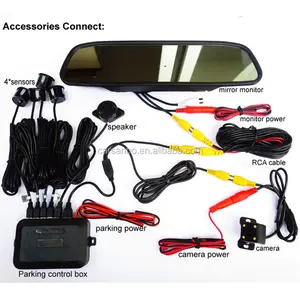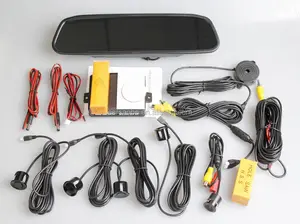Types of Rearview Mirror Parking Sensors
Rearview mirror parking sensors are essential tools in modern vehicles, enhancing safety and convenience during parking maneuvers. They come in various types, each designed to cater to specific needs and preferences. Here are some common types of rearview mirror parking sensors:
- Ultrasonic Sensors: These are the most common types of parking sensors. They use ultrasonic waves to detect obstacles. When a vehicle approaches an object while parking, the sensors emit sound waves that bounce off the object and return to the sensor. The system then calculates the distance to the object and alerts the driver with visual and audible cues. Ultrasonic sensors are known for their accuracy and reliability in detecting nearby obstacles.
- Electromagnetic Sensors: These sensors use electromagnetic fields to detect obstacles. They are typically installed behind the rear bumper and create a field that extends a few feet behind the vehicle. When an object enters this field, the sensor detects the disturbance and alerts the driver. Electromagnetic sensors are often less expensive than ultrasonic sensors, but they may have a shorter detection range and can be influenced by environmental factors.
- Laser Sensors: Laser sensors are a newer technology in parking assistance systems. They use lasers to scan the area around the vehicle and create a 3D map of the environment. This high level of detail allows for precise obstacle detection and tracking. Laser sensors can differentiate between various objects, such as pedestrians and parking pillars, adjusting the warning levels accordingly. Due to their advanced technology, laser sensors are often found in high-end vehicles or as part of an optional package.
- Radar Sensors: Radar sensors are typically used for rear cross-traffic alert and parking assistance. They use radar waves to detect moving objects near the vehicle. For example, when backing out of a parking space, the radar sensors can detect oncoming traffic from either side and alert the driver. Radar sensors are particularly useful in crowded parking lots where visibility is limited.
- Camera-Based Systems: Although not traditional parking sensors, camera-based systems are worth mentioning. These systems rely on rear cameras mounted on the vehicle to provide a live video feed of the area behind the car. Some advanced systems also include features like dynamic guidelines, which indicate the possible path of the vehicle's movement based on steering input. Camera-based systems enhance rear visibility and can help park more precisely, especially in tight spaces.
Specification and maintenance of rearview mirror parking sensors
Specifications of the rearview mirror parking sensor can vary depending on the vehicle model and the sensor system itself.
- Number of Sensors: The sensors are usually two to eight, depending on the vehicle's size and the parking assist system's complexity.
- Sensor Type: Ultrasonic sensors are the most common type of sensors used for parking assistance. These sensors emit sound waves and detect obstacles by measuring the time it takes for the sound waves to return after hitting an object.
- Detection Range: The detection range of parking sensors is typically between 1 to 2 meters (3 to 6 feet). It allows drivers to be aware of nearby obstacles when reversing or parallel parking.
- Display: Rearview mirrors with parking sensors often have integrated displays that show the distance to obstacles. Some advanced systems may also include visual representations of the surroundings.
- Audible Alerts: Proximity warnings may be issued through beeps or voice alerts. The frequency and pitch of the sound change as the vehicle approaches an obstruction, providing real-time feedback.
- Integration: Parking sensors are usually integrated into the vehicle's existing systems, such as the central control unit and the rearview mirror system, enabling seamless operation and coordination with other safety features.
- Power Supply: The parking sensor system is usually powered by the vehicle's electrical system. It is crucial to ensure proper electrical connections and voltage levels for optimal performance.
Maintaining the rearview mirror parking sensor is essential to ensure optimal performance and safety. Here are some tips to keep these sensors in good condition:
- Regular Cleaning: Keeping the parking sensors clean is essential to avoid inaccurate readings. Dust, dirt, or debris can interfere with their ability to detect obstacles. Use a mild soap and water solution to clean the sensors regularly, especially in dirty conditions.
- Avoid Abrasive Cleaners: When cleaning the parking sensors, avoid using abrasive cleaners or materials that could scratch the sensor's surface. Stick to gentle cleaning agents and soft cloths to preserve their functionality.
- Check for Obstructions: Periodically inspect the parking sensor area to ensure no obstructions, such as bumper stickers or aftermarket accessories, could obstruct the sensors' line of sight.
- Professional Inspection: Consider having a qualified mechanic or technician inspect the rearview mirror parking sensor system occasionally. They can check for proper function, sensor alignment, and potential electrical issues.
- Be Mindful of Modifications: If any modifications or repairs are made to the vehicle's rear bumper or parking sensor system, ensure they are done correctly and do not affect the sensors' performance.
- Sensor Calibration: In some cases, parking sensors may require periodic calibration to maintain accurate distance measurements. Consult the vehicle's owner's manual or contact the manufacturer for calibration recommendations.
How to choose rearview mirror parking sensors
When choosing suitable parking sensors for a business, consider the following factors:
- Understanding the vehicle's needs: Businesses need to assess their parking sensor requirements. For larger vehicles like trucks, your sensors may need to cover a more extensive area due to the vehicle's length. For luxury or high-end vehicles, there may be a need for features like cross-traffic alert due to parking in busy traffic lanes. Sensor coverage, vehicle size, and traffic conditions are all critical factors to consider.
- Evaluating installation requirements: Different parking sensor systems have varying installation complexities. While some may offer DIY installation with clear instructions, others may require professional installation, adding to the overall cost. Business owners need to consider whether they can install the sensors themselves or if they need to hire a professional.
- Durability and reliability: Businesses should select parking sensors designed to withstand harsh conditions in their operations. Factors such as extreme weather, exposure to dirt and dust, and heavy traffic are essential considerations. Choosing sensors with high IP ratings for water and dust resistance can prevent sensor damage and ensure long-term reliability.
- Maintenance: Business owners need to consider the maintenance requirements of parking sensors. While generally low-maintenance, some sensors may need regular cleaning to ensure optimal performance. Sensors exposed to harsh weather or heavy dust are more prone to debris buildup and may require frequent cleaning.
- Budget considerations: The cost of parking sensors varies based on model, features, and brand. Businesses need to assess the value each feature brings. For instance, while sensors with visual displays can help better understand the surroundings, audio-only sensors may be sufficient for smaller vehicles. Additionally, consider long-term benefits such as reduced vehicle wear, improved safety, and potential insurance savings when choosing parking sensors.
How to DIY and replace rearview mirror parking sensors
Here is how the sensor parking system can be installed:
-
Step one
Choose a suitable parking sensor kit. Making sure that the vehicle is clean and free from any debris that may interfere with the installation. The installation should be done on a level ground where the car is stable and doesn't move.
-
Step two
Park the vehicle in a well-lit area. Read the manufacturer's instructions to understand how the parking sensor system works. Preparing for the installation by gathering all necessary tools that will be used in installing the sensors. These may include screwdrivers, a drill, and a wire cutter.
-
Step three
Test the sensors before installing them. This is done by connecting the parking sensor system to the rearview mirror and turning it on to see if it is functional and working as required. The sensor systems should respond to obstacles when being tested.
-
Step four
After being sure that the parking sensor system is working well, proceed to install it. Follow the manufacturer's instructions to the latter. Ensure that the sensors are properly aligned and positioned to detect any obstacles when reversing the car.
-
Step five
Connect the parking sensor system to the vehicle's electrical system as per the manufacturer's instructions. Make sure that the connections are secure and tight to avoid any malfunctioning of the system.
-
Step six
Test the parking sensor system again to ensure that it is working properly and as required after the installation process is done. If the system is not functioning and giving the desired results, check the connections and the alignment of the sensors and make any necessary adjustments.
FAQ
Q1: Do all rearview mirrors have parking sensors?
A1: No, not all rearview mirrors have parking sensors. However, those without sensors can be upgraded to include them.
Q2: Can parking sensors be installed on any car?
A2: Yes, parking sensors can be installed on any car, regardless of its age or model.
Q3: Are wireless parking sensors available?
A3: Yes, wireless parking sensors are available. They reduce the need for extensive wiring, making the installation process easier and quicker.


































































































































































































































